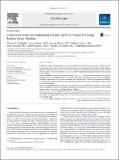Evidence for acute electrophysiological and cognitive changes following routine soccer heading
Abstract
Introduction There is growing concern around the effects of concussion and sub-concussive impacts in sport. Routine game-play in soccer involves intentional and repeated head impacts through ball heading. Although heading is frequently cited as a risk to brain health, little data exist regarding the consequences of this activity. This study aims to assess the immediate outcomes of routine football heading using direct and sensitive measures of brain function. Methods Nineteen amateur football players (5 females; age 22 ± 3 y) headed machine-projected soccer balls at standardized speeds, modelling routine soccer practice. The primary outcome measure of corticomotor inhibition measured using transcranial magnetic stimulation, was assessed prior to heading and repeated immediately, 24 h, 48 h and 2 weeks post-heading. Secondary outcome measures were cortical excitability, postural control, and cognitive function. Results Immediately following heading an increase in corticomotor inhibition was detected; further to these electrophysiological alterations, measurable reduction memory function were also found. These acute changes appear transient, with values normalizing 24 h post-heading. Discussion Sub-concussive head impacts routine in soccer heading are associated with immediate, measurable electrophysiological and cognitive impairments. Although these changes in brain function were transient, these effects may signal direct consequences of routine soccer heading on (long-term) brain health which requires further study.
Citation
Di Virgilio , T G , Hunter , A , Wilson , L , Stewart , W , Goodall , S , Howatson , G , Donaldson , D I & Ietswaart , M 2016 , ' Evidence for acute electrophysiological and cognitive changes following routine soccer heading ' , EBioMedicine , vol. 13 , pp. 66-71 . https://doi.org/10.1016/j.ebiom.2016.10.029
Publication
EBioMedicine
Status
Peer reviewed
ISSN
2352-3964Type
Journal article
Description
This work was supported by the National Institute for Health Research (NIHR) Brain Injury Healthcare Technology Cooperative. This work was supported by existing funding awarded to L.W. as part of Framework 7 programme of the European Union (CENTER-TBI, Grant number: 602150-2). The work made use of a TMS coil to which the company Smartfish contributed £1500 for purchase of. T.DiV.'s postgraduate study is support by the research office of Stirling University. W.S. is supported by a NHS Research Scotland Career Researcher Fellowship. D.I.D. and M.I. are members of SINAPSE – see www.sinapse.ac.uk.Collections
Items in the St Andrews Research Repository are protected by copyright, with all rights reserved, unless otherwise indicated.

